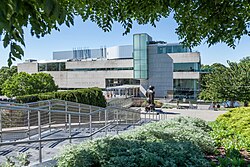
Back متحف فيرجينيا للفنون الجميلة Arabic متحف فيرجينيا للفنون الجميله ARZ Museu de Belles Arts de Virgínia Catalan Virginia Museum of Fine Arts German Museo de Bellas Artes de Virginia Spanish Musée des Beaux-Arts de Virginie French Museo di belle arti della Virginia Italian ვირჯინიის სახვითი ხელოვნების მუზეუმი Georgian Virginia Museum of Fine Arts Dutch Virginia Museum of Fine Arts Polish
 VMFA in 2010 | |
 Interactive fullscreen map | |
| Established | March 27, 1934 |
|---|---|
| Location | 200 N. Arthur Ashe Blvd., Richmond, VA 23220 |
| Coordinates | 37°33′22″N 77°28′30″W / 37.55611°N 77.47500°W |
| Type | Art museum |
| Accreditation | American Alliance of Museums |
| Key holdings | |
| Collections | Modern and Contemporary art |
| Collection size | 22,000 works (as of 2011)[1] |
| Director | Alex Nyerges |
| Architect | Rick Mather & SMBW (2010 addition) |
| Public transit access | Greater Richmond Transit Company bus route 16, stop at Grove Ave. between Thompson & Robinson. |
| Website | vmfa |
Virginia Museum | |
| Built | 1936 |
| Architect | Peebles & Ferguson |
| Architectural style | Georgian Revival; English Renaissance Revival |
| Part of | Boulevard Historic District (ID86002887[2]) |
| Designated CP | September 18, 1986 |
The Virginia Museum of Fine Arts (VMFA) is an art museum in Richmond, Virginia, United States, which opened in 1936. The museum is owned and operated by the Commonwealth of Virginia. Private donations, endowments, and funds are used for the support of specific programs and all acquisition of artwork, as well as additional general support.[3]
Considered among the largest art museums in North America for area of exhibition space,[4] the VMFA's comprehensive art collection includes African art, American art, British sporting art, Fabergé, and Himalayan art.[5] One of the first museums in the American South to be operated by state funds, VMFA offers free admission, except for special exhibits.
The VMFA, together with the adjacent Virginia Historical Society, anchors the eponymous "Museum District" of Richmond, and area of the city known as "West of the Boulevard".[6]
The museum includes the Leslie Cheek Theater, a performing-arts venue. For 50 years, a theater company operated here, known most recently as TheatreVirginia. Built in 1955 as a 500-seat theatre within the art museum, it started as a community theater and also hosted special programs in dance, film, and music. In 1969, the director established an Actors' Equity/LORT company known as Virginia Museum Theatre, hiring both local actors and professionals from New York City or elsewhere. Some of its productions received national notice. In 1973, its production of Maxim Gorky's play Our Father transferred to New York, to the Manhattan Theater Club. Because of continuing financial problems, the nonprofit theater closed in 2002. After renovation, it reopened in 2011 as part of the museum to host a range of live performance events.
- ^ "About the Collection". VMFA Website. Archived from the original on February 10, 2011. Retrieved February 28, 2011.
- ^ "National Register Information System". National Register of Historic Places. National Park Service. March 13, 2009.
- ^ "Agency Strategic Plan 2010–2012". Virginia Performs. Archived from the original on January 5, 2011. Retrieved March 10, 2011.
- ^ Tyler Green (May 24, 2010). "One of America's quietest museums quietly expands". blogs.artinfo.com. Archived from the original on June 28, 2010. Retrieved November 21, 2016.
- ^ "Fodor's Expert Review: Virginia Museum of Fine Arts". Fodor's Travel.
- ^ "History of the Museum District". Museum District Website. Museum District Association. Archived from the original on July 11, 2011.